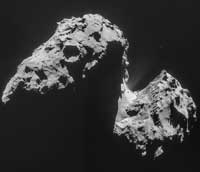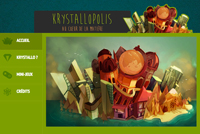Making new connections and learning in new ways Understand article
Science in School is published by EIROforum, a collaboration between eight of Europe’s largest inter-governmental scientific research organisations (EIROs). This article reviews some of the latest news from EIROs.

EIROforum combines the resources, facilities and expertise of its member organisations to support European science in reaching its full potential. See the list of EIROforum-related articles in Science in School.
CERN: Opening up the Higgs Hunt

Hunters database
Image courtesy of Higgs
Hunters
The hunt for the Higgs boson occupied many, many physicists at CERN, but now anyone can help analyse real data and perhaps find a new molecule. Higgs Hunters is a new website that shows you images from the ATLAS experiment in the hope you might spot something new that the scientists and their computers missed. The images on Higgs Hunters are snapshots of newborn particles flying at close to the speed of light through the huge underground ATLAS detector. Higgs particles rapidly decay and it’s hoped that the decay products might include new, unknown particles.

“Discovering what happens when a Higgs boson ‘dies’ could be even more exciting than the original discovery that the Higgs boson exists made at CERN back in 2012,” says Alan Barr, lead scientist of the Higgs Hunters project.
Don’t forget that the CERN education website hosts many more activities that you can use with your students. Based in Geneva, Switzerland, CERN is the world’s largest particle physics laboratory. See the list of CERN-related articles in Science in School.
 EMBL: Delighting in detail
EMBL: Delighting in detail

Laura Castaldi
This riot of colour is a visualisation of touch, or rather the skin nerves that relay that information. Neurons that detect gentle touch are shown in green, while red and blue represent two types of nerve cell involved in sensing pain. The image was obtained by Paul Heppenstall’s lab at EMBL Monterotondo, Italy, using a technique not previously used in live animals. “Already we’ve been able to see things that we couldn’t see before,” says Paul.
Skin seems designed to thwart fluorescence microscopy – not only is it a barrier, often preventing dyes from penetrating, but it also glows green under blue light. That means it’s hard to distinguish between the skin and fluorescent proteins, which are commonly used to label tissue. To get around the problem, Paul’s lab genetically engineered mice so their cells would produce a protein that binds to a specific chemical structure. The team then injected the mice with fluorescent probes that contained that structure. The protein binds to it and glues the probes in place, allowing the scientists to pinpoint the cells under the microscope.
Read more about this story on the EMBL news portal or read the original research article in Nature Methods:
Yang G et al. (2015) Genetic targeting of chemical indicators in vivo. Nature Methods, 12,137–139. doi: 10.1038/nmeth.3207
EMBL is Europe’s leading laboratory for basic research in molecular biology, with its headquarters in Heidelberg, Germany. See the list of EMBL-related articles in Science in School.

ESA: Teach with Rosetta

Rosetta mission
Image courtesy of ESA /
Rosetta / NAVCAM
On 12 November 2014, the Rosetta spacecraft’s Philae lander touched down on the surface of comet 67P/Churyumov–Gerasimenko: the most spectacular landing in the history of space exploration. Build on the extraordinary source of inspiration represented by the Rosetta mission to attract your students to science and technology.
The Teach with Rosetta website contains teaching materials for both primary- and secondary-school levels. The lessons use space, Rosetta and comets as a context for teaching curricular subjects from physics, chemistry, maths, biology and astronomy to comprehension, art and design. The site will grow with time, hosting new ESA education resources and links to Rosetta news as they become available during the course of the Rosetta mission, until its end in 2015.
ESA is Europe’s gateway to space, with its headquarters in Paris, France. See the list of ESA-related articles in Science in School.

ESO: Connect with ESO in your language

Friends of ESO can now connect with the organisation on social media platforms available in their native language. Together with volunteers, ESO has started making ESO’s latest news available in several languages on Facebook and Twitter.
The news items from ESO are already translated into more than 18 languages thanks to the ESO science outreach network. The network has also translated important parts of ESO’s website, as well as the ESO News weekly newsletter. Now, with the help of volunteers, the aim is to offer as many people as possible the chance to read ESO’s astronomical news on social media across language barriers.
View a list of ESO’s social media accounts. Those who wish to contribute translations for ESO local social media accounts which are still missing translations are invited to submit the form.
ESO is the world’s most productive ground-based astronomical observatory, with its headquarters in Garching near Munich, Germany, and its telescopes in Chile. ESO is a major partner in the revolutionary telescope ALMA and is building the 39-metre European Extremely Large Telescope, the E-ELT. View the list of ESO-related articles in Science in School.

EUROfusion: The European Commission launches EUROfusion

visualisation of EUROfusion’s
flagship experiment JET
Image courtesy of EUROfusion
After almost two years of preparation, the European Commission officially launched the European Consortium for the Development of Fusion Energy (EUROfusion) in autumn last year. EUROfusion manages the European fusion research activities on behalf of Euratom, which awards the appropriate grant to the consortium. The new consortium agreement substitutes the fourteen year-old European Fusion Development Agreement (EFDA), as well as 29 bilateral association agreements between the Commission and 28 European member states plus Switzerland. The formation of EUROfusion marks a big step forward for Europe’s quest to develop fusion power as a climate-friendly energy source that will contribute to meet a growing global energy demand. The EUROfusion Consortium enables Europe’s national laboratories to pool their resources even more efficiently – a measure which became necessary to meet the challenge of increasingly complex and large-scale projects such as ITER and DEMO. The preparation for such a joint fusion programme started in 2012.
The European Consortium for the Development of Fusion Energy (EUROfusion) comprises representations of 28 European member states as well as Switzerland and manages fusion research activities on behalf of Euratom. More than 40 European fusion laboratories collectively use the Joint European Torus (JET), which has remained the world’s largest magnetic fusion device since it was built in 1983. Smaller national experiments in Germany, Switzerland, and the United Kingdom complement the experimental programme. The aim is to realise fusion electricity by 2050. View the list of EUROfusion articles in Science in School.

European XFEL: Accelerator installation underway

section of the European XFEL
linear accelerator, which has
been nearly completely
assembled in the tunnel.
Image courtesy of DESY
To generate the world’s most intense X-ray flashes, European XFEL needs very high-energy electrons travelling at nearly the speed of light. To obtain flashes with laser-like quality, a linear particle accelerator is needed – in European XFEL’s case, a superconducting one that is nearly two kilometres in length.
This past summer, the German research centre DESY, which is European XFEL’s largest shareholder, began installing the first of 100 accelerator modules in the European XFEL accelerator tunnel beneath western Hamburg. Each module is twelve metres long and weighs ten tonnes.
The accelerator feeds large electromagnetic pulses into specially designed metal tubes called cavities. The electromagnetic pulses, combined with the shape of the cavities, create conditions that cause the electrons to move faster and faster. There will be 800 of these cavities in the European XFEL linear accelerator, eight in every module. Each cavity will be immersed in liquid helium to keep it at the necessary temperatures.
The European X-ray Free Electron Laser (European XFEL) is a research facility currently under construction in the Hamburg area in Germany. Its extremely intense X-ray flashes will be used by researchers from all over the world. See the list of European XFEL-related articles in Science in School.

ILL and ESRF: Exploring new ways to reach younger generations

In our digital world, science, education and communication are evolving at great speed. Connected devices, collaborative and free-content websites, social networks, gamification, fab labs and living labs become new ways for scientists to engage with the (young) public. During the International Year of Crystallography in 2014, ESRF and ILL have participated in various projects, from individual events to the development of innovative tools for educational purposes.

Krystallopolis website
The Krystallopolis website is an invitation to explore the world around us, which is full of (mostly invisible) crystals. The hunt for nanoscopic crystals is open! And, to prove that crystallography can be fun, Crystal Maze, Crystal Crush and quizzes help you play with crystals. The website has been developed in French and will be translated into English soon. It is a very useful resource to discover crystals and crystallography, for students, teachers and the general public.
vDiffraction
This ‘serious game’ about diffraction, which targets science students and teachers, is a fun way to enter the world of crystals. In crystals, atoms are arranged in a highly ordered structure with specific symmetries that are clearly visible in the diffraction patterns produced when crystals are hit by X-rays, neutrons or electrons. In vDiffraction, you become the scientist who has to identify the characteristic symmetries of a crystal. This is the first, crucial step towards understanding the atomic and molecular structure of a crystalline material.
Crystal game jam
In order to facilitate the development of new games about crystallography, we organised two simultaneous sessions, one in Grenoble, France, and one in Paris, France, with a total of about 40 participants who formed teams. A typical team comprised a game designer, an illustrator, a programmer and a scientist. Most of the participants were university students but some of them were secondary-school students. They had from Saturday morning to Sunday afternoon to develop their idea of a game and present a first draft. Among the ten games presented at the end of the crystal game jam, four were selected by a jury and their creators have been invited to participate in iGam4er, an international competition of video games for education and research, organised in Paris.
Geolocalised Crystal Z app
This smartphone app was a one-off initiative developed for the public during the three weeks of the Fête de la Science from late September to mid-October in Grenoble, where many events and activities focused on crystallography. The geolocalised Crystal Z app targeted mainly the young public, from 15 to 25 years old. The scenario included following a story (how a strange epidemic struck the population), going to various places and gaining crystals, answering scientific puzzles and playing ‘mini games’. Relying strongly on geolocalisation in the Grenoble area, it could also be played in other cities but with less interactivity.
More educational tools: card games, LED cubicle, Fourier transform demonstrator
These tools were conceived and developed for the International Year of Crystallography, mainly by students. From the simplest (card games for primary-school children) to the most advanced (Fourier transform demonstrator), they have been adapted to be used in schools or events such as the Fête de la Science.
Crystalline growth competition
In a more traditional way, a competition was run in more than 100 schools in Grenoble and its surrounding region. The objective was to grow the largest and most beautiful crystals, see http://concourscroissancecristaux2014.blogspot.fr and http://www.knowtex.com/nav/rires-et-cristaux-dans-l-amphi-du-cnrs_41649
ILL is an international research centre at the leading edge of neutron science and technology, based in Grenoble, France. Also situated in Grenoble, France, ESRF operates the most powerful synchrotron radiation source in Europe. Browse the lists of ILL- and ESRF-related articles in Science in School.






